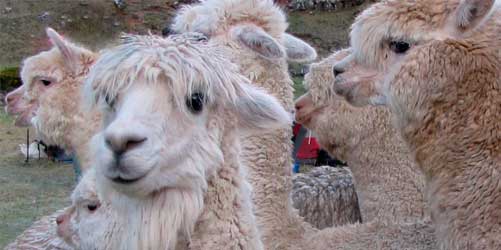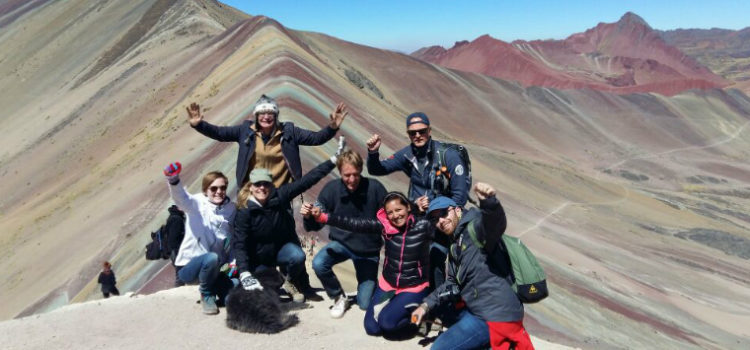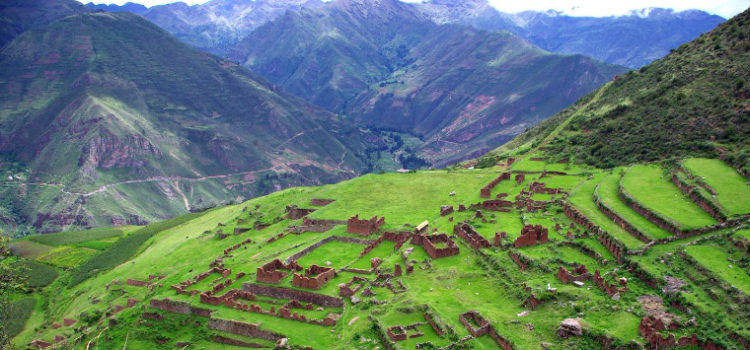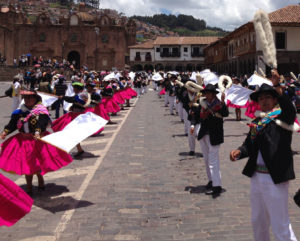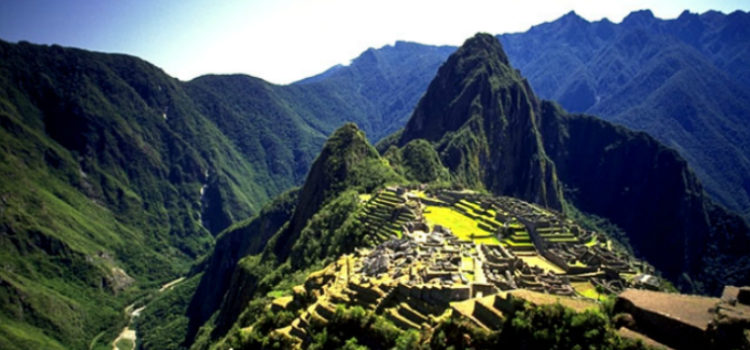Working together for a better future
Working together for a better future
At Andina Travel we believe that only by working together and including everybody we can achieve our goals for sustainable and eco-tourism. That is the reason why we consider the local people as our most important partners.
Community involvement – From Lares to Anta

What started in Lares fifteen years ago now reaches the Province of Anta: the operation of authentic tours and treks in the region by including the communities. Andina Travel constantly tries to introduce new Cusco treks into the more remote regions in order to better distribute the tourist masses that visit the region each year and to offer visitors less discovered, off-the-beaten track Peru Travel Packages far away from the crowds.
Most importantly, responsible tourism can provide a new opportunity for people living in those areas and improve their standard of living. By paying fair wages to the chefs and horse wranglers who mostly come from the regions in which we operate our Cusco treks, we support the families and local communities. A win-win situation for all of us.
However, the partnership doesn’t end here. Together with Dragoman Overland, a British tour operator, Andina Travel has helped to rebuild a primary school in Cuncani, giving local children access to education in their mother-tongue Quechua. Also the wages of the professors were paid by the company.
400 Alpacas and Llamas

For 200 years alpacas were extinct in some parts of the Andean Highlands surrounding Cusco. In 2014, after a study of the grass, which serves as food for the camelids, Andina Travel and Dragoman Overland have reintroduced alpacas to this region. It wasn’t the first re-introduction of alpacas, a few years ago the two companies already gave animals to the communities of the Lares Valley.
Purchased from Lorenzo Yupanqui a herder from Patacancha Community, little by little Andina Travel donated alpacas and llamas to different communities in the Anta Province. Today there are an estimated 400 alpacas, including their offspring, living in Lares and the Sacred Pampa of Anta. Andina Travel is still providing financial support for buying medicine and vaccination, however it is the local communites who are keeping care of their animals and are responsible for their well-being.
The local communities of Lares passed https://accisotret.com their expertise of shearing the alpacas, spinning and dying the wool to the people living in the Sacred Pampa. The wool is used for producing traditional clothing like ponchos and scarfs.
Reforestation
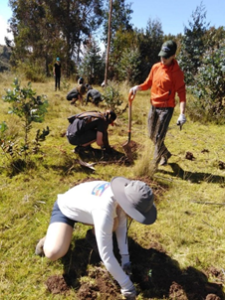
A few weeks ago the burning Amazon was on the headlines of all the newspapers around the world and global leaders all over the world promised to take action to save the rainforest that produces twenty percent of our CO2. Not only the rainforest was burning there have also been fires in the Sacred Pampa close to Zurite. Long before those happenings we have decided to take action to protect our environment.
In the province of Cusco we have established various reforestation programs in order to preserve our environment, flora and fauna. In the Sacred Pampa in the Andean highlands the trees also serve as a protection for the grass and therefore contribute to the survival of the alpacas. In total we have planted 6,000 trees in between Zurite and Ancuahuasi and in the Lares Valley and we’re still counting.
Sustainable Development Goals

Our actions align with the Sustainable Development Goals of the United Nations and we are working in nine out of seventeen categories. By providing fair wages to our employees who are living in the communities we fight poverty, reduce inequalities and positively contribute to decent work and economic growth in rural areas. We always encourage our passengers to donate prescription-free medication in isolated communities to ensure good health and wellbeing of the locals. For our Cusco treks our chefs buy local ingredients, support farmers of the region and at the same time make a contribution to responsible consumption and production.
Andina Travel also takes climate action and has planted 6,000 trees in the Lares Valley and the Sacred Pampa since its foundation. Thanks to our ‘no-trace-policy’ while operating our Peru Travel Packages, clean-up actions and the protection of our surroundings we protect life on land.
And last but not least we are investing into quality education for children by reconstructing school, paying wages for teachers and donating learning material. All this wouldn’t be possible if we haven’t established partnerships to achieve these goals – with the municipalities and the local people because together we are working for a better future in the Andes.
Alpacas Community Project – Next Stage
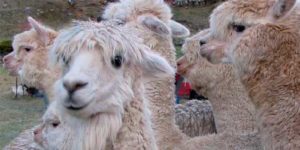 We dedicate this article to an update on our ongoing community project. Andina Travel works on a series of projects such as reforestation, reintroduction of Andean Camelids, reconstructions of schools and bridges together with Dragoman Overland from Britain. Both travel operators have worked together for over a decade. Our latest joint achievement has been a recent donation of a herd of twelve alpacas to local women weavers from Anta Province of Cusco Department. The alpaca is an animal species native of the Andes Mountains. Most of the world’s alpacas live in Peru. In this part of Cusco’s Cordillera Vilcabamba however these Andean Camelids were extinct for about 200 years. In 2013 we began the project of reintroduction of alpacas with a scientific study of the environment – especially the grasses, which would become food source for the animals. Since 2014 Andina Travel in close collaboration with Dragoman Overland has officially donated several alpaca and llama herds to the families along the Premium Inca Trail route. These communities previously didn’t have access to the benefits of outdoor tourism. This is the reason why Andina Travel and Dragoman Overland chose Anta Province of Cusco as next (once the activities in the Lares area had been successfully concluded).
We dedicate this article to an update on our ongoing community project. Andina Travel works on a series of projects such as reforestation, reintroduction of Andean Camelids, reconstructions of schools and bridges together with Dragoman Overland from Britain. Both travel operators have worked together for over a decade. Our latest joint achievement has been a recent donation of a herd of twelve alpacas to local women weavers from Anta Province of Cusco Department. The alpaca is an animal species native of the Andes Mountains. Most of the world’s alpacas live in Peru. In this part of Cusco’s Cordillera Vilcabamba however these Andean Camelids were extinct for about 200 years. In 2013 we began the project of reintroduction of alpacas with a scientific study of the environment – especially the grasses, which would become food source for the animals. Since 2014 Andina Travel in close collaboration with Dragoman Overland has officially donated several alpaca and llama herds to the families along the Premium Inca Trail route. These communities previously didn’t have access to the benefits of outdoor tourism. This is the reason why Andina Travel and Dragoman Overland chose Anta Province of Cusco as next (once the activities in the Lares area had been successfully concluded).
What’s the Difference Between Llamas and Alpacas?
Llamas and alpacas are two types of domesticated South American Camelids (there also are two wild species: guanacos and vicuñas). Llamas are taller than alpacas. They produce wool and make great off-road pack animals. A llama can carry about 20 – 25% of its weight. The Incas used llamas to transport goods, food, and alike long distances over the diverse Andean terrain. Today the locals train their llamas to carry outdoor gear for trekkers.
Alpacas are bred for wool too; their wool is much finer, especially the first baby alpaca shear. Alpaca Suri has long dreadlocks-like hair whereas Alpaca Huacaya has poodle-like fluffy fur. Alpaca Suri is the second finest fiber that exists right after silk and Vicuña. Alpaca meat has been consumed since pre-Inca times. It is a very healthy choice, because the meat is lean.
Why the Quillarumiyoc Location?
It is very important for us to treat the local people as partners, so we coordinated with the local association of weavers, the local municipal authorities, and the local branch of the Peruvian Ministry of Culture. It was collectively decided and approved that the next herd of alpacas is going to be placed near the Quillarumiyoc Inca Temple on the Pampa of Anta.
This archeological site was unknown to tourism until about two and a half years ago when Andina Travel had explored and had launched a brand new trekking route to Machu Picchu. This five-day trail follows the footsteps of the Incas on a central section of the ceremonial Inca Trail that connected the Cusco Capital to Machu Picchu during the Imperial Era. Since about two and a half years ago the Pampa of Anta and the communities along the route have been benefiting from the positive effects of tourism. This region has been put on the map of tourism and the number of visitors to the Quillarumiyoc Temple and the Premium Inca Trail has been steadily growing. Other tour operators began to offer visits to the Quillarumiyoc Temple; however our Premium Inca Trail (otherwise known as the Wild Andes Trek) is still an exclusive off-the-beaten-path trekking route that allows the trekkers to experience the in-the-middle-of-nowhere feel hiking in the Peruvian Andes. More and more tourists come to Cusco and Machu Picchu each year. If the tourism is to stay sustainable it is crucial to continue developing new trekking routes as well as new non-trekking options to offer to the visitors, so that no one region becomes overly saturated and so that more local people can be included in an opportunity to ‘make a [better] future out of their connection with the past’.*
A Special Day
14th February this year Jose Luis Olivera the general manager of Andina Travel and the tour conductor Adam Thomas representing Dragoman Overland co-signed the documents officially donating a herd of 12 alpacas to the local women from Weaving Association. The heard of alpacas was purchased from Lorenzo Yupanqui a herder from Patacancha Community above Ollantaytambo town in the Sacred Valley of the Incas. He is one of our trekking cooks, but he also provides important veterinary support for the donated animals and teaches the communities from Anta how to best take care of their alpacas and llamas.
The February day was a lovely festive occasion. Adam, Jose Luis, the trekkers, and all the local authorities were received very warmly by the local women. They prepared a celebratory meal; a typical dish of quinoa, cuy (guinea pig) and potatoes, and chicha de frutilla – a fermented drink made of wild strawberries – for the toast and offering to the Pachamama. It is always special when our clients get to see a result of the community project to which they contributed via choosing their vacation. The excitement was palpable in the air and we all experienced once again that joy transcends language and culture.
We believe that the alpacas will soon get used to their new home and can’t wait to learn how many alpaca babies will be born next year!
* Mice, Lares Valley – Peru’s ethical trekking by Melisa Hurd
Rainbow Mountain
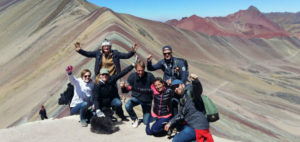 The Rainbow Mountain otherwise known as Motaña de Siete Colores (Mountain of Seven Colors) or Vinicunca (original Quechua name of the location – kunka means ‘neck’ in English) is stunning. The sedimentation of different minerals and the geological forces that lifted the peaks to 5,100m (16,732 ft.) resulted in a truly spectacular view that visitors from near and far come to experience. No need to be an expert outdoor person, however the hike to the top is challenging, so this trip requires good acclimatization – at least full 48 hours in Cusco altitude – and some preparation.
The Rainbow Mountain otherwise known as Motaña de Siete Colores (Mountain of Seven Colors) or Vinicunca (original Quechua name of the location – kunka means ‘neck’ in English) is stunning. The sedimentation of different minerals and the geological forces that lifted the peaks to 5,100m (16,732 ft.) resulted in a truly spectacular view that visitors from near and far come to experience. No need to be an expert outdoor person, however the hike to the top is challenging, so this trip requires good acclimatization – at least full 48 hours in Cusco altitude – and some preparation.
Inca Trail to Machu Picchu
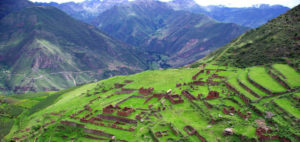 The Qhapaq Ñan, also known as the Andean Road System or Inca Trail is ‘the most extensive and advanced transportation system in pre-Columbian South America.’[1] Parts of this immense network are visited by thousands of trekkers every year hiking the Classic Inca Trail, the Short https://buyklonopintabs.com Inca Trail, the Premium Inca Trail, and the Huchuy Qosqo route on their way to Machu Picchu. Comuneros still transit the Andean paths, as they are often their only way home connecting the pre and the post-colonial history.[2] ‘Of the sixty thousand kilometers that make up the Qhapaq Ñan, nearly half run through Peruvian territory.’ [3] The rest can be found in Argentina, Bolivia, Chile, Colombia, and Ecuador. 25% of the original structure survived till today and is now protected by UNESCO; the rest was destroyed by the Spanish conquest and building of modern infrastructure. [4]
The Qhapaq Ñan, also known as the Andean Road System or Inca Trail is ‘the most extensive and advanced transportation system in pre-Columbian South America.’[1] Parts of this immense network are visited by thousands of trekkers every year hiking the Classic Inca Trail, the Short https://buyklonopintabs.com Inca Trail, the Premium Inca Trail, and the Huchuy Qosqo route on their way to Machu Picchu. Comuneros still transit the Andean paths, as they are often their only way home connecting the pre and the post-colonial history.[2] ‘Of the sixty thousand kilometers that make up the Qhapaq Ñan, nearly half run through Peruvian territory.’ [3] The rest can be found in Argentina, Bolivia, Chile, Colombia, and Ecuador. 25% of the original structure survived till today and is now protected by UNESCO; the rest was destroyed by the Spanish conquest and building of modern infrastructure. [4]
Peruvian Holidays 2
 Peru has too many holidays to fit into one article. Cusco is an important Peruvian cultural hub, but it is not the only one. Each of the Peruvian regions has its unique folkloric and religious expressions – some of them world famous and rightfully so. What celebrations are popular throughout the Peruvian coast? Which festival is as big as the Rio Carnival? Don’t miss them on your Peruvian holidays!
Peru has too many holidays to fit into one article. Cusco is an important Peruvian cultural hub, but it is not the only one. Each of the Peruvian regions has its unique folkloric and religious expressions – some of them world famous and rightfully so. What celebrations are popular throughout the Peruvian coast? Which festival is as big as the Rio Carnival? Don’t miss them on your Peruvian holidays!
Peruvian Holidays
Touring Peru
 In Peru all roads lead to Machu Picchu. The Qhapaq Ñan the road network of Tahuantinsuyo – The Inca Empire – embodies this. If Machu Picchu is among the new World Wonders, so should be Qhapaq Ñan, which became a UNESCO World Heritage Site in 2014. Many of the yearly visitors come to Machu Picchu hiking parts of Qhapaq Ñan through routes like the Classic Inca Trail, the Premium Inca Trail, or Huchuy Qosqo to Machu Picchu. It is no surprise that Machu Picchu is the climax of the journey through Peru.
In Peru all roads lead to Machu Picchu. The Qhapaq Ñan the road network of Tahuantinsuyo – The Inca Empire – embodies this. If Machu Picchu is among the new World Wonders, so should be Qhapaq Ñan, which became a UNESCO World Heritage Site in 2014. Many of the yearly visitors come to Machu Picchu hiking parts of Qhapaq Ñan through routes like the Classic Inca Trail, the Premium Inca Trail, or Huchuy Qosqo to Machu Picchu. It is no surprise that Machu Picchu is the climax of the journey through Peru.
However, Peru has so much more to offer. There are the three different environments of costa – the coast, sierra – the mountains, and selva – the jungle and there are many different civilizations that rose and fell through the long pre-latino history of today’s Peru.
Machu Picchu Mountain
 Machu Picchu citadel sits between two mountains: the Young Peak – Huayna Picchu and the less famous Old Peak – Machu Picchu Mountain or Cerro Machu Picchu. This mountain located opposite to Huayna Picchu on the other side of Machu Picchu between the city itself and Inti Punku – Sun Gate, which is the entrance point to Machu Picchu Citadel from the Classic Inca Trail trekking route. The location of Machu Picchu Mountain offers a spectacular panoramic view of the Inca Citadel, Huayna Picchu, Putucusi Mountain, the River Urubamba, and the surrounding landscape with the snowy Andean peaks in the background.
Machu Picchu citadel sits between two mountains: the Young Peak – Huayna Picchu and the less famous Old Peak – Machu Picchu Mountain or Cerro Machu Picchu. This mountain located opposite to Huayna Picchu on the other side of Machu Picchu between the city itself and Inti Punku – Sun Gate, which is the entrance point to Machu Picchu Citadel from the Classic Inca Trail trekking route. The location of Machu Picchu Mountain offers a spectacular panoramic view of the Inca Citadel, Huayna Picchu, Putucusi Mountain, the River Urubamba, and the surrounding landscape with the snowy Andean peaks in the background.
Machu Picchu, Inca Trail, and the Famous
 Machu Picchu World Heritage Site is about 1000 meters lower in the altitude than the former Inca Capital Cusco. Visit to the archeological site doesn’t require any particular level of fitness, which is among the many reasons why Machu Picchu attracts people from all over the world including the royals and the famous. The 42 kilometers (26 miles) of the Classic Inca Trail trekking route is a very different challenge. And it gets individuals no less extraordinary to push their limits on the most well-known trekking route of South America.
Machu Picchu World Heritage Site is about 1000 meters lower in the altitude than the former Inca Capital Cusco. Visit to the archeological site doesn’t require any particular level of fitness, which is among the many reasons why Machu Picchu attracts people from all over the world including the royals and the famous. The 42 kilometers (26 miles) of the Classic Inca Trail trekking route is a very different challenge. And it gets individuals no less extraordinary to push their limits on the most well-known trekking route of South America.
Machu Picchu Pictures
Machu Picchu has something to offer to every visitor. The scientists from different fields continue to understand its harmony with the surrounding environment and the universe. Hikers climb the steep narrow Inca paths to the mountain tops. Photographers look for the best light and camera angle to take that perfect picture. People from all over the world come to fulfill their dream. Machu Picchu continues to fascinate us. This visual essay will take you on a journey around the most iconic spots of Machu Picchu close up.


